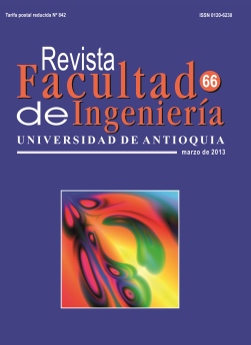A bit more on the ability of adaptation of speech signals
DOI:
https://doi.org/10.17533/udea.redin.15042Keywords:
speech signals, wavelet coefficients, similarity, ability of adaptationAbstract
Some traditional digital signal processing techniques encompass enhancement, filtering, coding, compression, detection and recognition. Recently, it has been presented a new hypothesis of signal processing known as the ability of adaptation of speech signals: an original speech signal may sound similar to a target speech signal if a relocation process of its wavelet coefficients is applied. This hypothesis is true under some conditions theoretically defined. In this paper we present the basic idea behind the hypothesis of adaptation and moreover, we test the hypothesis within four cases: speech signals with the same gender and language, speech signals with the same gender but different language, speech signals with the same language but different gender, and speech signals with different gender and language. It is found that the hypothesis is true if the requirements are satisfied, even if the gender or the language of the original and target signals are not the same.
Downloads
References
Y Hu, P. Loizou. “Speech enhancement based on wavelet thresholding the multitaper spectrum”. IEEE Transactions on Speech and Audio Processing. Vol. 12. 2004. pp. 59- 67. DOI: https://doi.org/10.1109/TSA.2003.819949
Y. Ghanbari, M. Karami. “A new approach for speech enhancement based on the adaptive thresholding of the wavelet packets”. Speech Communication. Vol. 48. Issue 8. 2006. pp. 927-940. DOI: https://doi.org/10.1016/j.specom.2005.12.002
Yu Shao, C. Hong. “A Generalized Time-Frequency Subtraction Method for Robust Speech Enhancement Based on Wavelet Filter Banks Modeling of Human Auditory System”. IEEE Transactions on Systems, Man, and Cybernetics. Vol. 37. 2007. pp.877-889. DOI: https://doi.org/10.1109/TSMCB.2007.895365
S. Senapati, S. Chakroborty, G. Saha. “Speech enhancement by joint statistical characterization in the Log Gabor Wavelet domain”. Speech Communication. Vol. 50, 2008. pp. 504-518. DOI: https://doi.org/10.1016/j.specom.2008.03.004
M. Eshaghi, M. Karami. “Voice activity detection based on using wavelet packet”. Digital Signal Processing. Vol. 20. 2010. pp. 1102-1115. DOI: https://doi.org/10.1016/j.dsp.2009.11.008
C. Hsieh, E. Lai, Y. Wang. “Robust speech features based on wavelet transform with application to speaker identification”. IEEE Proceedings Vision, Image and Signal Processing. Vol. 149. 2002. pp. 108- 114. DOI: https://doi.org/10.1049/ip-vis:20020121
O. Farooq, S. Datta. “Wavelet-based denoising for robust feature extraction for speech recognition”. Electronics Letters. Vol.39. 2003. pp. 163-165. DOI: 10.1049/el:20030068 DOI: https://doi.org/10.1049/el:20030068
E. Avci, Z. Hakan Akpolat. “Speech recognition using a wavelet packet adaptive network based fuzzy inference system”. Expert Systems with Applications. Vol. 31. 2006. pp. 495-503. DOI: https://doi.org/10.1016/j.eswa.2005.09.058
J. Hung, H. Fan. “Subband Feature Statistics Normalization Techniques Based on a Discrete Wavelet Transform for Robust Speech Recognition”. IEEE Signal Processing Letters. Vol. 16. 2009. pp. 806-809. DOI: https://doi.org/10.1109/LSP.2009.2024113
S. Joseph, P. Babu. Speech compression using wavelet transform. International Conference on Recent Trends in Information Technology (ICRTIT). 2011. DOI: https://doi.org/10.1109/ICRTIT.2011.5972258
M. Osman, N. Al, H. Magboub, S. Alfandi. Speech compression using LPC and wavelet. Second International Conference on Computer Engineering and Technology (ICCET). 2010. DOI: https://doi.org/10.1109/ICCET.2010.5485348
Z. Dan, M. Shengqian. Speech Compression with Best Wavelet Packet Transform and SPIHT Algorithm. Second International Conference on Computer Modeling and Simulation. 2010.
R. Veldhuis, H. He. “Time-scale and pitch modifications of speech signals and resynthesis from the discrete short-time Fourier transform”. Speech Communication, Vol. 18. 1996. pp. 257-279. DOI: https://doi.org/10.1016/0167-6393(95)00044-5
D. Ballesteros, J. Moreno. “On the ability of adaptation of speech signals and data hiding”. Expert Systems with Applications. Vol. 39. 2012. pp. 12574-12579. DOI: https://doi.org/10.1016/j.eswa.2012.05.027
D. Ballesteros, J. Moreno. “Highly transparent steganography model of speech signals using Efficient Wavelet Masking”. Expert Systems with Applications. Vol. 39. 2012. pp. 9141-9149. DOI: https://doi.org/10.1016/j.eswa.2012.02.066
S. Mallat. Wavelets and Filters Banks. A wavelet tour of signal processing. 2nd Edition. Ed. Academic Press. Second Edition. 1999. pp. 255-264.
J. Benesty, C. Jingdong, H. Yiteng. “On the Importance of the Pearson Correlation Coefficient in Noise Reduction”. IEEE Transactions on Audio, Speech, and Language Processing. 2008. pp. 757-765. DOI: https://doi.org/10.1109/TASL.2008.919072
J. Benesty, C. Jingdong, H. Yiteng, I. Cohen. “Pearson Correlation Coefficient, in: Noise Reduction in Speech Processing”. Springer Topics in Signal Processing. Vol. 2. 2009. pp. 1-4. DOI: https://doi.org/10.1007/978-3-642-00296-0_5
Downloads
Published
How to Cite
Issue
Section
License
Copyright (c) 2018 Revista Facultad de Ingeniería

This work is licensed under a Creative Commons Attribution-NonCommercial-ShareAlike 4.0 International License.
Revista Facultad de Ingeniería, Universidad de Antioquia is licensed under the Creative Commons Attribution BY-NC-SA 4.0 license. https://creativecommons.org/licenses/by-nc-sa/4.0/deed.en
You are free to:
Share — copy and redistribute the material in any medium or format
Adapt — remix, transform, and build upon the material
Under the following terms:
Attribution — You must give appropriate credit, provide a link to the license, and indicate if changes were made. You may do so in any reasonable manner, but not in any way that suggests the licensor endorses you or your use.
NonCommercial — You may not use the material for commercial purposes.
ShareAlike — If you remix, transform, or build upon the material, you must distribute your contributions under the same license as the original.
The material published in the journal can be distributed, copied and exhibited by third parties if the respective credits are given to the journal. No commercial benefit can be obtained and derivative works must be under the same license terms as the original work.










 Twitter
Twitter